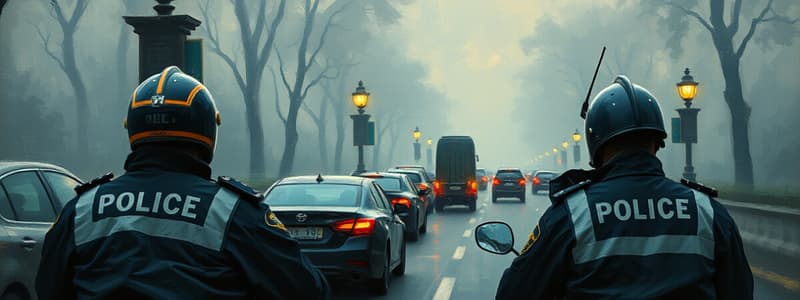Podcast
Questions and Answers
What action should be taken if injuries are considered life threatening or life changing?
What action should be taken if injuries are considered life threatening or life changing?
- Inform the media about the incident immediately.
- Remove all vehicles from the scene right away.
- Deploy a Senior Investigating Officer (SIO) and start a Road Death/Serious Injury Investigation Log. (correct)
- Only contact the ambulance service.
Who is responsible for coordinating multi-agency responses at a road incident scene?
Who is responsible for coordinating multi-agency responses at a road incident scene?
- The local fire department.
- The recovery operator.
- The ambulance service.
- The police. (correct)
What is one of the initial actions that must be communicated to other services at the scene?
What is one of the initial actions that must be communicated to other services at the scene?
- The presence of any special road conditions. (correct)
- The identity of all individuals involved in the incident.
- The expected arrival times of each agency.
- The number of emergency vehicles on site.
What should happen before a vehicle is removed from the incident scene?
What should happen before a vehicle is removed from the incident scene?
What is the role of the recovery operator at an incident scene?
What is the role of the recovery operator at an incident scene?
What is emphasized regarding the sharing of information at the incident scene?
What is emphasized regarding the sharing of information at the incident scene?
What should officers do once the carriageway is confirmed to be safe for traffic?
What should officers do once the carriageway is confirmed to be safe for traffic?
Why is it important to remove advance warning signs as soon as practicable?
Why is it important to remove advance warning signs as soon as practicable?
At what speed limit is a stopping distance of 120 ft (36 m) required?
At what speed limit is a stopping distance of 120 ft (36 m) required?
When officers remove cones, how far should they remain from the rear of the police vehicle?
When officers remove cones, how far should they remain from the rear of the police vehicle?
What is the stopping distance for a speed limit of 60 mph?
What is the stopping distance for a speed limit of 60 mph?
How should officers position themselves while working in a coned area?
How should officers position themselves while working in a coned area?
What is the stopping distance required at a speed limit of 70 mph?
What is the stopping distance required at a speed limit of 70 mph?
What is the recommended procedure after removing cones?
What is the recommended procedure after removing cones?
What should the minimum distance for cone tapers depend on?
What should the minimum distance for cone tapers depend on?
Why is it important not to make an island with the cones?
Why is it important not to make an island with the cones?
What should be done if the taper is too severe?
What should be done if the taper is too severe?
Where should coning start according to the guidelines?
Where should coning start according to the guidelines?
What is the preferred practice regarding the hard shoulder during a road traffic incident?
What is the preferred practice regarding the hard shoulder during a road traffic incident?
How should police vehicles be positioned during a coning operation?
How should police vehicles be positioned during a coning operation?
Which vehicle should display full emergency rear facing lighting?
Which vehicle should display full emergency rear facing lighting?
What is the main objective of coning at a road traffic collision?
What is the main objective of coning at a road traffic collision?
What is a distinguishing feature of electric vehicles (EVs)?
What is a distinguishing feature of electric vehicles (EVs)?
What type of battery is commonly found in electric vehicles?
What type of battery is commonly found in electric vehicles?
What could happen to an electric vehicle's battery if it is damaged?
What could happen to an electric vehicle's battery if it is damaged?
Which hazard is presented to officers by electric and hybrid vehicles (E&HVs)?
Which hazard is presented to officers by electric and hybrid vehicles (E&HVs)?
What happens to the high voltage system in an electric vehicle during a collision?
What happens to the high voltage system in an electric vehicle during a collision?
Which of the following features might not indicate that a vehicle is electric?
Which of the following features might not indicate that a vehicle is electric?
What should officers be aware of regarding fires in electric vehicles?
What should officers be aware of regarding fires in electric vehicles?
What is a common misconception about the identification of electric vehicles?
What is a common misconception about the identification of electric vehicles?
What precaution should officers take regarding electric vehicles (EVs) during armed incidents?
What precaution should officers take regarding electric vehicles (EVs) during armed incidents?
What should officers do if they encounter an unidentifiable vehicle at a road traffic collision (RTC)?
What should officers do if they encounter an unidentifiable vehicle at a road traffic collision (RTC)?
Which type of extinguishers should not be used on vehicle fires involving EVs?
Which type of extinguishers should not be used on vehicle fires involving EVs?
Why should officers be cautious of re-ignition in EVs after an incident?
Why should officers be cautious of re-ignition in EVs after an incident?
What should officers avoid doing in relation to the 400V orange cables in EVs?
What should officers avoid doing in relation to the 400V orange cables in EVs?
What precaution related to water immersion should officers keep in mind?
What precaution related to water immersion should officers keep in mind?
What should officers do if they are unsure about whether a vehicle is electric or hybrid?
What should officers do if they are unsure about whether a vehicle is electric or hybrid?
What is the primary threat that officers should be aware of regarding EV batteries?
What is the primary threat that officers should be aware of regarding EV batteries?
Flashcards are hidden until you start studying
Study Notes
Road Traffic Collision Management
- Coning on motorways and dual carriageways requires distances based on the speed limit, with a minimum distance for each closed lane.
- The aim of coning is to gradually direct traffic away from an obstruction to prevent further collisions.
- Complete lanes should be coned, never part of a lane, and isolation between lanes of live traffic should be avoided.
- Coning begins at the taper point, and in stationary traffic, it may be necessary to clear coned areas starting from the police vehicle.
- Preferably, the hard shoulder should remain open for emergency service access.
- Only the rear police vehicle in closed lanes should have full emergency lighting activated to serve as a ‘line of defense.’
Police Procedures and Safety Protocols
- The removal of cones and signs should be done systematically, starting from the incident site towards the warning signs.
- Officers should work facing oncoming traffic while within the coned area.
- Speed limits correlate with stopping distances and required coning distances, ranging from 15m to 100m behind police vehicles depending on speed limits (30mph to 70mph).
- Life-threatening injuries at a scene may necessitate the deployment of a Senior Investigating Officer (SIO) and a formal investigation log.
- Police must coordinate with other emergency services for scene management and to maintain safe traffic flow.
Electric and Hybrid Vehicle Hazards
- Electric vehicles (EVs) contain high-voltage lithium-ion batteries, typically encased in steel, raising distinct hazards.
- EV features include charging flaps, absence of exhaust pipes, unique dashboard controls, and non-standard parking mechanisms.
- Officers face significant risks including electric shock, potential fires that can reignite, and exploding batteries from vehicle damage.
- Precautions include avoiding the use of EVs for cover in armed incidents and assessing vehicle types before engagement.
Incident Response Protocols
- Do not approach unidentified vehicles without prior consultation with recovery services if life isn't immediately endangered.
- Firefighting with water or foam on EV fires is ineffective and can exacerbate hazards; small extinguishers are inadequate.
- Risks of re-ignition after extinguishing could persist for weeks; immersion in water is not a reliable safety measure.
- Under no circumstances should 400V orange cables or earth straps be cut to avoid electric shock hazards.
Studying That Suits You
Use AI to generate personalized quizzes and flashcards to suit your learning preferences.




